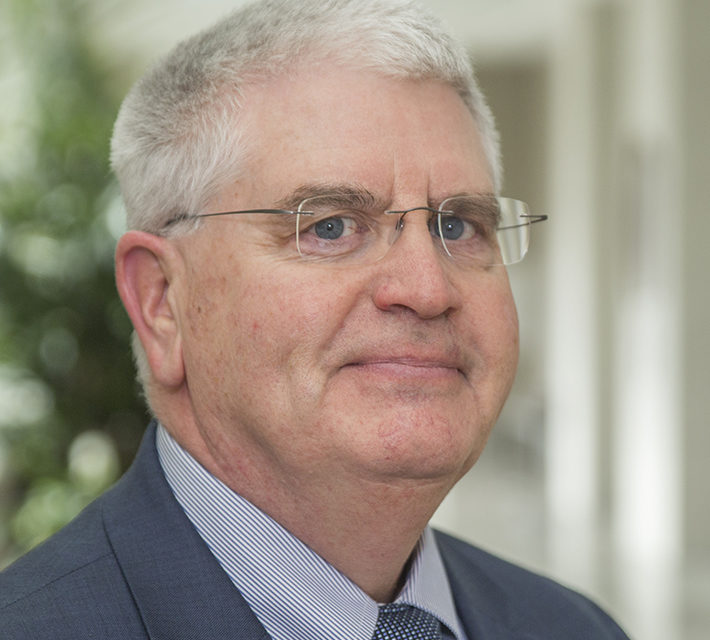
On the Record with Stan Lynall, Vice President of Venture Investments, OSF Ventures

As healthcare systems across the country wrestle with how much to invest in innovation, Peoria-based OSF HealthCare is putting its money where its mouth is. It’s among a growing number of systems that have created corporate venture arms to invest in early stage medical device and digital health companies.
OSF’s board of directors voted to set aside $75 million, which has helped fund more than a dozen projects since 2016. They range from a telehealth platform for behavioral health services to precision medicine software.
The solutions are often piloted among OSF’s clinicians, who sometimes provide additional mentoring and feedback to the companies.
“We look for new technologies that can improve patient outcomes and patient and family experiences in their healthcare journey,” Stan Lynall, vice president of venture investments for OSF, said in a recent interview with Health News Illinois. “We also look for technologies that can reduce the cost of healthcare.”
Lynall also discussed the potential of machine learning, what technology he sees as making the biggest impact on healthcare and why he thinks the digital health market is opening up.
Edited excerpts are below.
HNI: Why is this a priority for OSF?
SL: We would not be doing the venture program if it weren’t for the broader focus on finding new and better ways of delivering healthcare, which is a core focus of our innovation strategy. The venture program is a piece of that strategy, but only a piece. We are committed to digital transformation — transforming healthcare in ways that are necessary for providers like us to remain viable and relevant. A key part of that is finding ways to improve patient outcomes, finding ways to engage with members of our communities that we have a presence in, even before they have a need to engage with us regarding their healthcare. It’s part and parcel of the movement to value-based care and away from fee-for-service care, which is slowly happening across our country.
And so we felt that the venture program could be a key piece of this innovation strategy by finding early stage technology companies across the country that can bring a meaningful difference in the way we serve patients and the outcomes that we generate. And also to help us with the cost curve as well.
HNI: How many of the solutions that you invest in are then piloted in your health system?
SL: What we do is that our venture program invests in med tech, which is typically medical devices or diagnostics. And then we also invest in digital health solutions, which are typically IT based solutions. On the digital health side, it’s very common for us to pilot test the technologies. On the med tech side, it’s a little more difficult to actually pilot because the devices and diagnostics require regulatory approval. So what we can do though is find other ways to contribute to the company. We can arrange for the company to help direct access to clinicians for problem solving, for mentoring or for general feedback as they’re developing their products. That’s very common. Ultimately we can become a formal clinical trial site for medtech technologies. Sometimes that happens, sometimes it doesn’t.
On the digital health side we have an innovation partnerships group that identifies clinicians within our system that we believe would have interest in the given technology. They’re kind of the go between between the technology company that we’ve invested in and a particular group of clinicians. And they help design an appropriate pilot test. They help determine appropriate measurements and ways to monitor the progress of the deployment. That particularly happens on the digital health side. I would say that surely more often than not with the companies we’re investing in, we’re testing the technology in some way.
HNI: What’s the future of machine learning and AI in healthcare?
SL: AI and machine learning is evolving and has emerged as one of the focus technologies in healthcare. I would say over the last 12 to 18 months we’re seeing a lot more new technologies. When you think about it, healthcare is rich in data, right? We have a lot of data. And what I think we’re now seeing is we’re on the front end of an emerging space that could be incredibly valuable to healthcare and the way that we diagnose illnesses. And also in providing guidance in the most appropriate ways to treat illnesses based on the nature of the disease state and the nuances. So we are really focused in this area. We expect the market to be very prevalent with technologies and the AI machine learning space. And we believe it has the chance or the opportunity to very definitely positively impact how patients are diagnosed and treated. So we’re very open to evaluating technologies in this space. We expect over the next few years for this to be a very prevalent area of new technologies.
HNI: What other technologies are going to have the biggest impact on people’s health?
SL: I think the whole patient engagement space — ways for providers like us to engage with patients to be better informed about their care needs to provide the basis for more direct and focused education to patients around their particular healthcare needs or their disease state. I think we’re expecting to see a lot in this area. The mobile applications are becoming more prevalent. As providers find ways to effectively integrate digital mobility into their modes of communicating with patients and engaging patients. We expect to see a lot of advancement in this particular space.
HNI: As healthcare becomes more personalized, what steps are you taking to ensure that patient data is private and secure?
SL: This is a critical, critical area. We are very cognizant of the need for thorough evaluation of the security aspects of the technologies we evaluate. We have a very vibrant IT internal team and that team is engaged with our innovation work in order to ensure that information is kept secure and in compliance with all federal and state regulations. Certainly, security risk is prevalent when you move into the world of mobility and apps in this type of thing. We are really extremely careful in making sure that we evaluate the security around all these technologies. It applies to virtually everything we look at these days and for this reason we’ve included IT professionals directly in our innovation work and have engaged with our large internal IT group for assistance in evaluating these technologies on a regular basis. They’re part of our team.
HNI: While there have certainly been incredible advancements in healthcare, some would argue that the industry has lagged beyond others in terms of technological innovation. Do you agree with that? And if so, why?
SL: It’s probably lagged behind until very recent times. Healthcare is a highly regulated industry for obvious reasons. And just as we spoke about the need for security around data and patient information, as compared with other industries, it’s probably caused the technology evolution in healthcare to lag a bit. I would say the old model of healthcare delivery was probably not as conducive to the need for new technology, the old fee-for-service model, which we’re slowly but surely kind of migrating away from to more value-based care. I think the fundamentals of value-based care open up the opportunities for technologies to be more prevalent in healthcare. I think there’s a visibility these days about the need and the benefit of new technologies in healthcare that quite frankly was not nearly as visible even six or eight or 10 years ago.
We’re entering into a new space in healthcare and we see it all across the country. There’s many incubator and accelerator programs that assist entrepreneurs in getting off the ground. There’s venture programs like ours that are driven by healthcare systems that are fundamentally more strategically focused in their work then financially focused, which I think is going to prove to be a value in the whole evolution of technology and healthcare. And there’s capital available, not only in the traditional hotbeds of technology like Silicon Valley and perhaps the Boston area. But more widely geographically available, including the Midwest. We’re seeing a lot of new technology efforts and success in the Chicago area for example, which we’ve supported and been part of. So I think all of these things speak to an opening of the market in healthcare technology and we’re really excited about it.
HNI: As this market opens up what can policymakers do to keep that going?
SL: With respect to the regulatory approval process and the FDA, many have shared a view historically that that has been a very slow and cumbersome process for new technology. And so we are seeing, I believe, the beginning of a recognition on the part of the FDA and the federal government of the benefits of technology and the need for them to be more efficient in their processes of review and approval while maintaining the stringent regulatory oversight that’s necessary for patient safety. And we’re seeing recognition at the FDA of the emergence of digital solutions and perhaps what their role could be in review and approval and facilitation of digital solutions coming to market where appropriate. So I think these are all great steps and hopefully will continue.
Image courtesy of OSF Healthcare.









